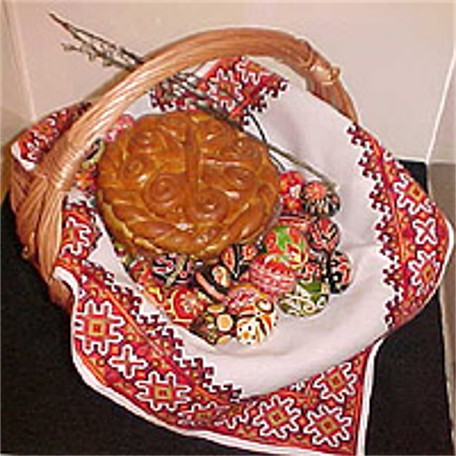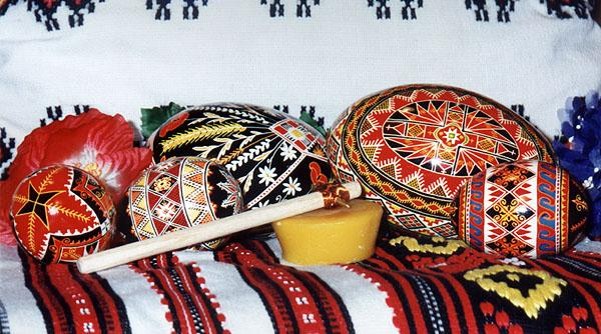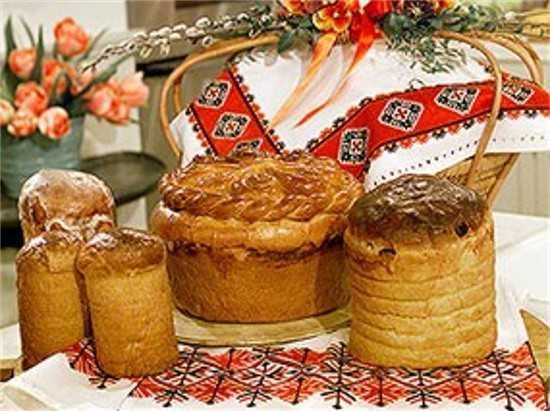Easter
Easter. The feast of Christ's resurrection, which in its observance combines both pagan and Christian elements. It was celebrated at different times by different churches, often at the same time as the Jewish Passover. In 325, the Council of Nicea decided that Easter must be observed everywhere on the same Sunday—the first after the full moon following the vernal equinox—and that whenever the full moon fell on a Sunday, Easter would be postponed for a week to avoid coinciding with Passover. The Orthodox church and Eastern-rite Catholic church adhere to the Julian calendar and a different ‘paschal moon’ and so celebrate Easter on a different Sunday.
In Ukrainian, Easter is called Velykden (The Great Day), a term used in early Rus’ translations of John Damascene. In Ukraine Easter has been celebrated over a long period of history and has had many rich folk traditions that are no longer fully preserved.
The last Sunday before Easter (Palm Sunday) is called Willow Sunday (Verbna nedilia). On this day pussy-willow branches are blessed in the church. The people tap one another with these branches, repeating the wish: ‘Be as tall as the willow, as healthy as the water, and as rich as the earth.’ They also use the branches to drive the cattle to pasture for the first time, and then the father or eldest son thrusts his branch into the earth for luck.
The week before Easter, the Great (Velykyi) Week (Holy Week), is called the White (Bilyi) or Pure (Chystyi) Week. During this time an effort is made to finish all field work before Thursday, since from Thursday on work is forbidden. On the evening of ‘Pure’ (also called ‘Great’ or ‘Passion’ [Strasnyi]) Thursday, the passion (strasti) service is performed, after which the people return home with lighted candles. Maundy Thursday, called ‘the Easter of the dead’ in eastern Ukraine, is connected with the cult of the dead, who are believed to meet in the church on that night for the Divine Liturgy.
On Passion (Strasna) Friday—Good Friday—no work is done. In some localities, the Holy Shroud (plashchanytsia) is carried solemnly three times around the church and, after appropriate services, laid out for public veneration.
Easter is the principal spring festival (see Spring rituals), and a series of rites have become centered around it that, in the distant past, were connected with the Annunciation, with Saint George, and even with the rites of the winter cycle, especially those of New Year's Day. Easter rites preserve traces of pre-Christian rites, which in general show a striking similarity to those of Christmas and New Year's. These rites are closely related to agriculture, to the remembrance of the dead, and to the marriage season; during their performance, praise is given, ritual songs are sung, and there is much well-wishing.
Easter is a feast of joy and gladness that unites the entire community in common celebration. For three days the community celebrates to the sound of bells and to the singing of spring songs—vesnianky (see Vesnianky-hahilky). Easter begins with the Easter matins and high liturgy, during which the pasky (traditional Easter breads) and pysanky and krashanky (decorated or colored Easter eggs) are blessed in the church. Butter, lard, cheese, roast suckling pigs, sausage, smoked meat, and little napkins containing poppy seeds, millet, salt, pepper, and horseradish are also blessed. After the matins all the people in the congregation exchange Easter greetings, give each other krashanky, and then hurry home with their baskets of blessed food (sviachene). In eastern Ukraine they go home, place the sviachene on the table, and the oldest member of the family opens the cloths in which the food is wrapped, slices pieces from each item, and distributes them to members of the family along with a piece of unleavened bread that has also been blessed. In Western Ukraine, especially in the Hutsul region, the people first walk around the house three times, go to the stable, extend Easter greetings to the cattle, touch them with the sviachene, scatter pieces of Easter bread and salt in the manger, and send holiday greetings to the bees. Only then do they enter the house, ceremoniously open the bundle (dorinnyk) over the heads of the children, and sit down to the table to break their fast.
In Western Ukraine at Easter the girls perform special choral dances on the church grounds. These are the haivky or hahilky, which have retained a number of motifs that are older than those of the ordinary spring songs (vesnianky). They have a greater amount of ritual in them and contain elements of the round dance, of mimicry, and of choral composition.
The krashanky and pysanky (Easter eggs) are an old pre-Christian element and have an important role in the Easter rites. They are given as gifts or exchanged as a sign of affection, and their shells are put in water for the rakhmany (peaceful souls); finally, they are placed on the graves of the dead or buried in graves and the next day are taken out and given to the poor. Related to the exchange of krashanky is the rite of sprinkling with water, which is still carried on in Western Ukraine on the second day of Easter (Wet Monday, Oblyvanyi ponedilok); it is practiced by young people, the boys usually splashing the girls with water.
During the Easter season in Ukraine the cult of the dead is observed. The dead are remembered on Maundy Thursday and also during the whole week after Easter (called the ‘Week of the Nymphs’ [navskyi tyzhden], especially on the first Sunday following Easter Sunday (called Khomyna [Thomas's] or Providna [Seeing-off]). For the commemoration of the dead (provody) the people gather in the cemetery by the church, bringing with them a dish containing some food and liquor or wine, which they consume, leaving the rest at the graves.
Not many of these traditions are observed today in Ukraine, and only some, having lost their full meaning, are kept in the diaspora as symbolic rituals.
BIBLIOGRAPHY
Kylymnyk, S. Ukraïns’kyi rik u narodnikh zvychaiakh v istorychnomu osvitlenni, 1 (Winnipeg 1955)
Voropai, O. Zvychaï nashoho narodu, 2 vols (Munich 1958–66)
Ilarion [Ohiienko, I.]. Dokhrystyians’ki viruvannia ukraïns’koho narodu (Winnipeg 1965)
Kurochkin, O. Novorichni sviata ukraïntsiv (Kyiv 1978)
Z. Kuzelia, P. Odarchenko


.jpg)
.jpg)

.jpg)
